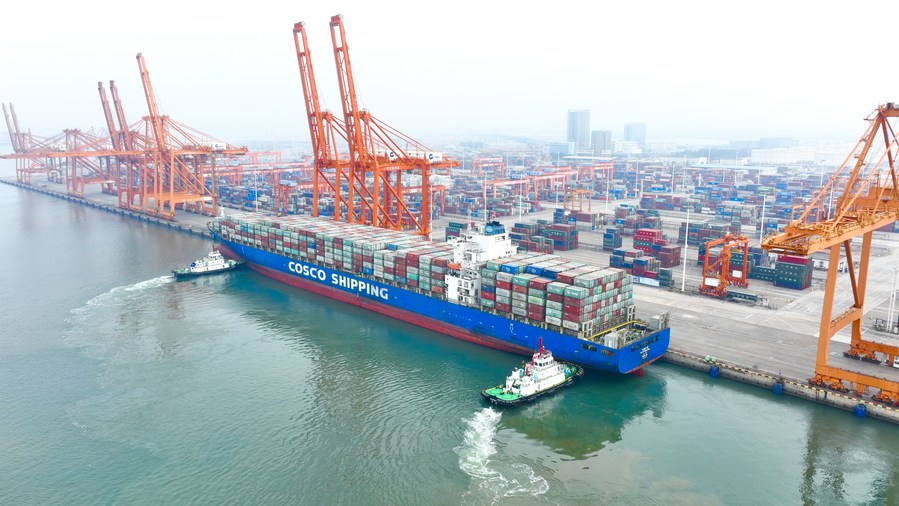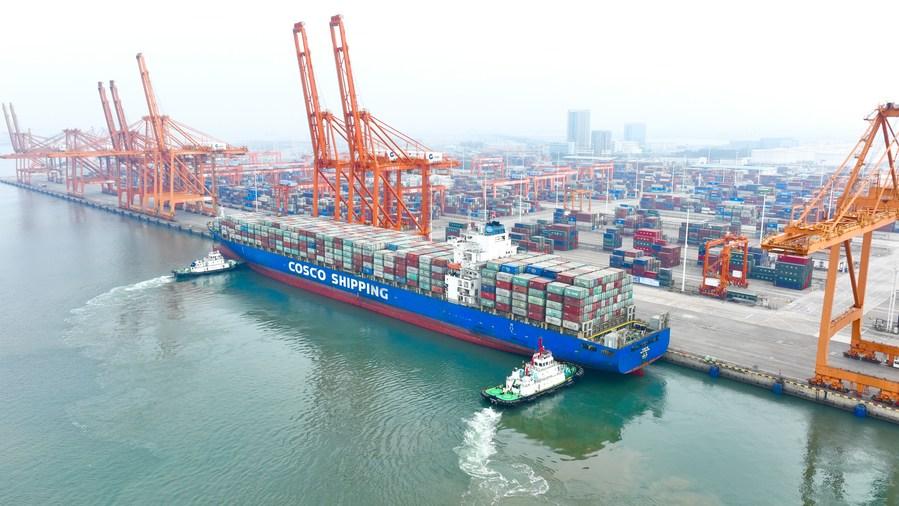
Photo taken on March 2, 2022 shows a container terminal of Qinzhou Port in south China's Guangxi Zhuang Autonomous Region.(Xinhua)
BEIJING, Feb. 9 (Xinhua) -- China has achieved better-than-expected results in foreign trade in 2022, with the use of foreign investment maintaining growth. In 2023, the country will make more efforts in stabilizing foreign trade and foreign investment.
-- Promoting stable foreign trade development with optimized structure
China's imports and exports hit a new high of 42 trillion yuan in 2022, and the structure was further optimized, with exports by private enterprises accounting for 60.8 percent of the total, an increase of 3.2 percentage points, introduced Li Xingqian, head of the Foreign Trade Department of the Ministry of Commerce (MOC).
China's foreign trade unleashed new growth drivers in 2022, with the exports of electric vehicles, photovoltaic products and lithium batteries growing by 131.8 percent, 67.8 percent and 86.7 percent, respectively. Meanwhile, new business forms like cross-border e-commerce and market procurement trade boomed, registering an import and export volume of over 3 trillion yuan, accounting for more than 7 percent of the total foreign trade, according to Li.
China's foreign trade made new contributions in 2022, noted Li. The net exports of goods and services boost a GDP growth of 0.5 percentage point, with the contribution rate reaching 17.1 percent. Besides, China's stable development of production and exports also helped smooth the operation of global industrial and supply chains. Its imports notched 2.7 trillion U.S. dollars, contributing to global economic and trade development.
More efforts will be made in 2023 to promote the stable development and the optimization of structure of foreign trade, including strengthening connections between suppliers and purchasers to stabilize export trade, expanding imports of quality products, deepening trade innovation, and pushing forward sustained, rapid and healthy development of cross-border e-commerce, overseas warehouses and other new business forms, according to Li.
-- Uplifting quality of foreign investment
China achieved scale increase and structure and quality improvement in foreign investment in 2022, making positive contributions in stabilizing the overall economy, introduced Meng Huating, head of the Department of Foreign Investment Administration with the MOC.
The foreign investment flowing into the Chinese market reached a record high in 2022, with the actual use of foreign capital exceeding 1.2 trillion yuan for the first time, up 6.3 percent year on year on a comparable basis, or reaching 189.13 billion U.S. dollars, up 8 percent.
The actual use of foreign capital in the manufacturing sector increased by 46.1 percent yer on year to 323.7 billion yuan, while that in high-tech industries increased by 28.3 percent to 444.95 billion yuan, with that in high-tech manufacturing and high-tech services increasing by 49.6 percent and 21.9 percent, respectively.
The investment from the Republic of Korea, Germany, the United Kingdom and Japan rose by 64.2 percent, 52.9 percent, 40.7 percent and 16.1 percent, respectively, while that from the European Union (EU), the Belt and Road countries and the Association of Southeast Asian Nations (ASEAN) rose by 92.2 percent, 17.2 percent and 8.2 percent, respectively. The actual use of foreign capital in the eastern, central and western regions of China grew by 4.7 percent, 21.9 percent and 14.1 percent, respectively.
In the next step, efforts will be made to appropriately reduce the negative list for foreign investment, further open up the modern service sector, solve difficulties encountered by enterprises, encourage foreign investment in areas like advanced manufacturing, modern services, energy conservation and environmental protection, and scientific and technological innovation, attract more investment in high-tech industries, and improve the quality of investment, according to Meng.
-- Giving full play to the positive role of the RCEP
The MOC has worked with relevant departments to implement the rules and market access commitments under the Regional Comprehensive Economic Partnership (RCEP) trade pact at a high level, guiding and supporting localities, industries and enterprises to seize opportunities and expand trade and investment cooperation with other RCEP countries, with fruitful results yielded, introduced MOC Assistant Minister Guo Tingting.
China's imports and exports with other RCEP countries in 2022 hit 12.95 trillion yuan, up 7.5 percent year on year and accounting for 30.8 percent of the country's total foreign trade. China made 17.96 billion U.S. dollars of non-financial direct investment in other RCEP countries, up 18.9 percent, and attracted 23.53 billion U.S. dollars of direct investment from these countries, up 23.1 percent.
In 2022, the certificates of origin under the RCEP applied for and the declarations of origin issued by Chinese export enterprises registered 673,000 in total, bringing export preferential treatment to 235.3 billion yuan of goods, which might enjoy 1.58 billion yuan of tariff concessions from importers. A total of 65.3 billion yuan of goods imported by Chinese enterprises enjoyed import preferential treatment, with the tax relief recording 1.55 billion yuan.
China has made use of mechanisms such as the ministerial meeting to encourage more RCEP members to ratify the pact, and meanwhile worked closely with other members to jointly fulfill tax reduction obligations, implement facilitation measures, improve the business environment and enhance the implementation of the pact.
The MOC will continue to promote the high-quality implementation of the RCEP, push for continuous release of the benefits of the pact, and give full play to the positive role of the RCEP in stabilizing foreign trade and foreign investment, and promoting cooperation in industrial and supply chains, as well as high-quality development, according to Guo.
(Edited by Gu Shanshan with Xinhua Silk Road, gushanshan.1987@163.com)




 A single purchase
A single purchase









